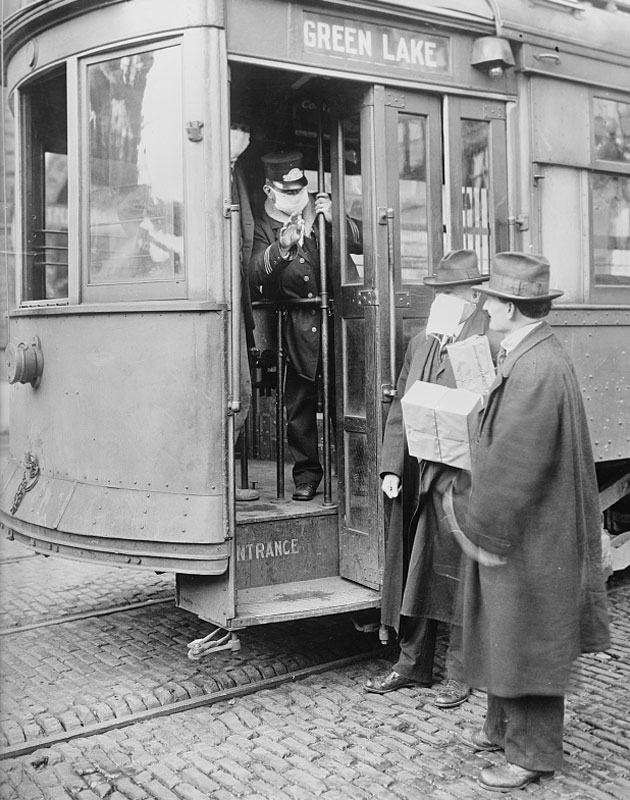Pandemic 1918
The last time a pandemic put Dallas on lockdown, it was Oct. 10, 1918, and the City’s public health officer downplayed it.
Dallas Health Officer Dr. A.W. Carnes warned that influenza was coming, but said it was “only slightly more severe than common grippe.”
The “Spanish flu,” so-called because the pandemic spread among men returning from Europe after World War I, killed 50 million people worldwide between 1918 and 1920.
At least 9,000 people in Dallas contracted the disease, and 250 died, between Sept. 24 and Nov. 2, 1918, according to influenzaarchive.org, which contains well-researched essays on the 1918 flu epidemic, courtesy of the University of Michigan Center for the History of Medicine.
The essay about Dallas says the health officer resisted shutting down commerce and shamed Dallasites for being unhygienic: “Your failure to clean up might be the cause of your wife or your child becoming infected with this new plague which is daily claiming a toll of lives. Let us make Dallas the cleanest city in the country as a preventive measure.”
Meanwhile, hospitals were overwhelmed with flu patients, who had to be quarantined. There weren’t enough nurses, and every nursing student, retired nurse and anyone with any kind of medical training, were being asked to work in the hospitals. An outbreak of whooping cough among babies in South Dallas added to the nursing shortage.
Imagine this scene: “At the Buckner Orphans’ Home, 200 of the 500 children and two nurses were sick with influenza; the nine teachers there cared for the ill.”
From the Influenza Archive:
“Dr. V. P. Armstrong, Assistant Health Officer, believed that Dallas’s epidemic was already far worse than being reported, and that the only way to bring it to a quick halt was to close all public places immediately. ‘This disease is spread through the breathing apparatus, and the thing to do is to close all of the schools, the moving picture shows, the churches — wherever people congregate, whether it be a dog fight or a prayer meeting,’”
On Saturday, Oct. 12, Dallas Mayor Joseph E. Lawther went against the majority of the board of health and ordered the closing of all public and private schools, churches and other public gatherings, two days after closing theaters, playhouses and all other places of public amusement.
“I am taking this action not because the situation in our city is alarming,” he told residents. “But as a measure of safety and precaution and because it seems to be the desire of our citizenship.”
By that time, there were already more than 1,000 cases of flu in Dallas. The flu was not eliminated during the citywide shutdown, but the number of cases started to decrease.
Churches and schools were getting restless, and on Oct. 31, Lawther and Carnes agreed to reopen schools, churches and commerce in time for Catholic and Episcopal churches to observe All Saints Day. On Nov. 2, the downtown theaters and shops reopened. Cases of the flu continued to decrease, although there was a resurgence in December that killed an additional 80 people.
From the Influenza Archive:
“It is difficult to ascertain the severity of Dallas’s epidemic. Beginning on Sept. 27, Carnes requested that physicians report influenza cases, but the ensuing ordinance did not become law until Oct. 12, leaving a significant gap for which case reporting was not mandatory. We will never know how many cases slipped through the cracks during this lag. In addition, most health departments devoted significant space to the influenza epidemic in their 1918 annual reports, providing detailed analyses of the timeline of the epidemic, the number of cases each month, or even each week, for some cities. Dallas’s, however, has nary a word on the epidemic. In fact, health officers were immensely more interested in smallpox, malaria, typhoid fever, and impure food and milk than they were with influenza and the destruction it wrought. The only information provided is the total number of lobar pneumonia and influenza deaths for the period between May 1918 and May 1919: 813 in all, equaling a death rate for those diseases of 511 per 100,000.”






